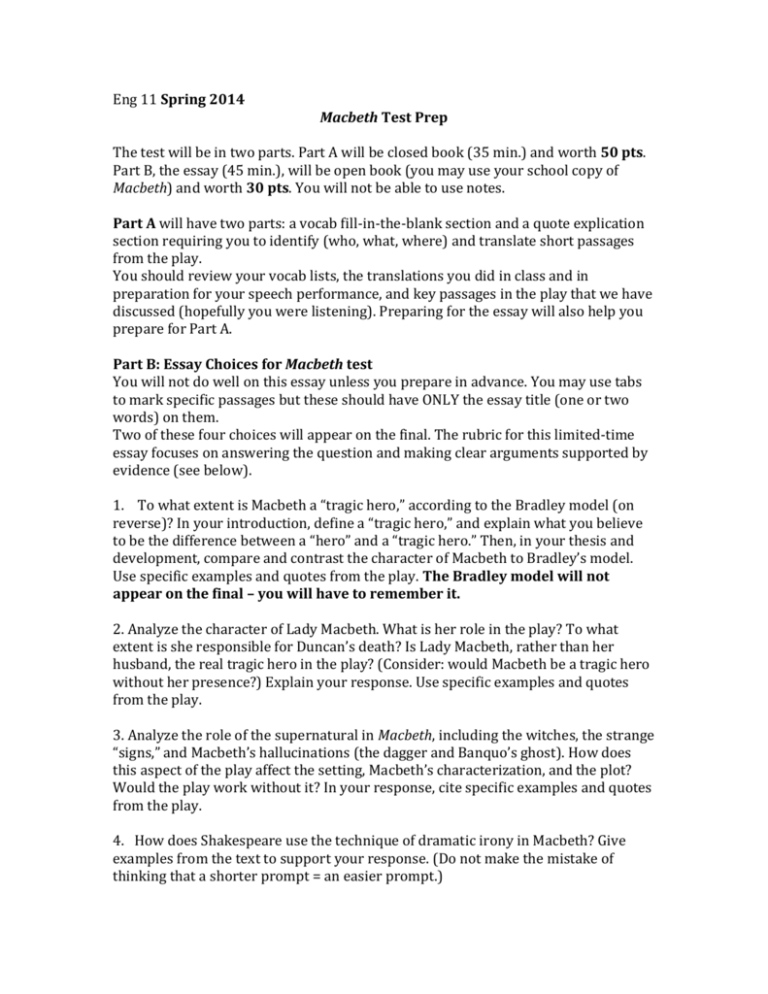Part B: Essay Choices for Macbeth test
advertisement

Eng 11 Spring 2014 Macbeth Test Prep The test will be in two parts. Part A will be closed book (35 min.) and worth 50 pts. Part B, the essay (45 min.), will be open book (you may use your school copy of Macbeth) and worth 30 pts. You will not be able to use notes. Part A will have two parts: a vocab fill-in-the-blank section and a quote explication section requiring you to identify (who, what, where) and translate short passages from the play. You should review your vocab lists, the translations you did in class and in preparation for your speech performance, and key passages in the play that we have discussed (hopefully you were listening). Preparing for the essay will also help you prepare for Part A. Part B: Essay Choices for Macbeth test You will not do well on this essay unless you prepare in advance. You may use tabs to mark specific passages but these should have ONLY the essay title (one or two words) on them. Two of these four choices will appear on the final. The rubric for this limited-time essay focuses on answering the question and making clear arguments supported by evidence (see below). 1. To what extent is Macbeth a “tragic hero,” according to the Bradley model (on reverse)? In your introduction, define a “tragic hero,” and explain what you believe to be the difference between a “hero” and a “tragic hero.” Then, in your thesis and development, compare and contrast the character of Macbeth to Bradley’s model. Use specific examples and quotes from the play. The Bradley model will not appear on the final – you will have to remember it. 2. Analyze the character of Lady Macbeth. What is her role in the play? To what extent is she responsible for Duncan’s death? Is Lady Macbeth, rather than her husband, the real tragic hero in the play? (Consider: would Macbeth be a tragic hero without her presence?) Explain your response. Use specific examples and quotes from the play. 3. Analyze the role of the supernatural in Macbeth, including the witches, the strange “signs,” and Macbeth’s hallucinations (the dagger and Banquo’s ghost). How does this aspect of the play affect the setting, Macbeth’s characterization, and the plot? Would the play work without it? In your response, cite specific examples and quotes from the play. 4. How does Shakespeare use the technique of dramatic irony in Macbeth? Give examples from the text to support your response. (Do not make the mistake of thinking that a shorter prompt = an easier prompt.) Macbeth, the Tragic Hero (Bradley Model) Shakespearean Heroes and Their Character Flaws In his book, Shakespearean Tragedy, A.C. Bradley presents several characteristics typical of Shakespearean heroes: First, they are all exceptional beings in that they are persons of high degree or public importance. They are often kings or military leaders; thus, their downfalls have great consequences, affecting often the welfare of whole nations. Secondly, Shakespearean heroes cause their own downfalls. The calamities in a Shakespearean tragedy do not just happen by accident, nor are they sent from above. Rather, they proceed from the hero’s own actions. Lastly, Shakespearean tragic heroes all possess a character flaw. This character flaw can be described in several ways, but it can be basically characterized by the hero’s having a definite predisposition toward one particular action. As the play proceeds, the hero will begin directing his entire efforts towards one interest or object. He becomes, in time, incapable of resisting. Thus, this character flaw ultimately results in the death of the hero. RUBRIC Thesis (10 pts.): Thesis answers the question directly and includes a road map of your arguments. Development (10 pts.): 3-5 paragraphs, each with a topic sentence that is arguable, not indisputable fact or a quote. Topic sentences follow the order of the road map. Any transitions or links between topic sentences, and between topic sentence and the thesis, should be IN THE TOPIC SENTENCES themselves. Clarity and support (10 pts.) Your arguments are coherent, and you choose appropriate and adequate evidence from the play to support your arguments. Your quotes include context and fit into your sentences grammatically. Quotes are cited by act, scene, and line using this format: (V.ii.32-33). 



